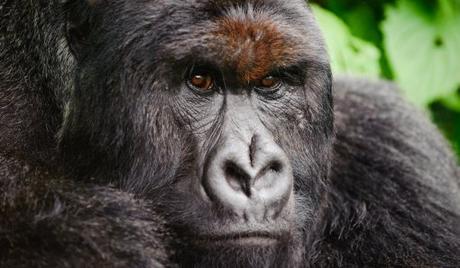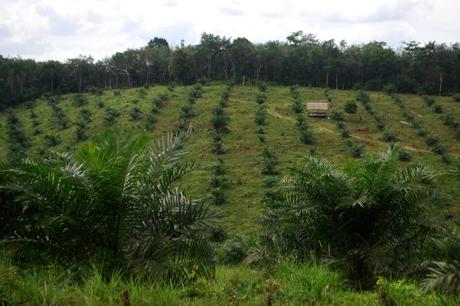
A new article just published in PNAS reveals how future expansion of the palm-oil industry could have terrible consequences for African primates.
Researchers from the European Commission’s Joint Research Centre, CIRAD, Liverpool John Moores University, and ETH Zurich searched for “areas of compromise” combining high oil palm suitability with low primate vulnerability, as possible locations where to accommodate new oil-palm plantations while reducing detrimental effects on primate populations.
Results show that there is small room for compromise. In fact, potential areas of compromise are rare across the whole African continent, covering a total extent of 0.13 Mha of land highly suited to oil palm cultivation where primate vulnerability is low, rising to just 3.3 Mha if all land with at least minimum suitability to grow oil palm is taken into account.
Palm oil production is steadily rising, and expected to accelerate in response to growing world’s population, with future demand driven not only by the food industry, but also by the biofuel market.

Oil palm plantation at the border of intact forest. Jambi – Indonesia, 2011. ©Center For International Forestry Research/Iddy Farmer
Although most oil palm is currently produced in Southeast Asia and South America, Africa is considered a likely destination for new plantations, thanks to the high availability of low-lying, tropical ecosystems highly suitable to profitable oil palm cropping. The lessons learned from the catastrophic impact of industrial oil palm plantations on wildlife in Southeast Asia have prompted the international team to produce a broad assessment of the expected effects of oil palm expansion on African primate diversity, highlighting the challenges ahead.
The choice of focusing on primates was motivated by several reasons. The most obvious one is that primates are a priority for conservation, because the populations of many species are already in steep decline due to habitat loss following conversion of natural land to agriculture, logging and mining.
Indeed, 37% of primate species in mainland Africa, and 87% of species in Madagascar, are threatened with extinction.
“Primates offer also a synthetic view on ecosystem health, as they play an important role in seed dispersal and maintaining the composition of forest communities”,
explains lead author Giovanni Strona, from European Commission.
“Furthermore, primate diversity correlates with species richness of other taxonomic groups, which implies that the potential impact of future oil palm expansion we modelled for primates might likely extend to biodiversity in general. Finally, the home ranges of most African primate species are relatively well known, which makes it possible to use them confidently in large-scale analyses.”

To produce their assessment, the researchers first combined information on the distribution of 193 African primate species and their threat status, producing a map of primate vulnerability at a scale of 10 × 10 km. Then, they compared this map with another one detailing oil palm suitability. The two maps revealed striking similarities across sub-Saharan Africa, with areas of high primate vulnerability and oil palm suitability overlapping in equatorial and forested regions in West and Central Africa.
As anticipated, the extent of areas where to grow oil palm successfully without eating away at primate habitat is small, accounting for only 6.2% of the land that would be required to cope with oil palm demand by 2050 (53 Mha). Such a small percentage is reduced even further to 0.2% if the analysis is limited to high suitable land only.
“A potential mitigation strategy would be to identify alternative trajectories for agricultural expansion, using ‘smart’ criteria and delaying the loss of primate range as much as possible,”
says Ghislain Vieilledent, an ecologist from CIRAD and co-author of the study.
Acknowledging that the real world application of such criteria can be problematic, the researchers compared two income-driven, oil-palm expansion scenarios (based on either land suitability or accessibility) and two conservation-driven scenarios (based either on minimising carbon dioxide emissions or first converting areas of low primate vulnerability).

The scenario maximising suitability led to the highest cumulative loss of primate habitat, while in the primate vulnerability scenario, the number of primate species affected by oil-palm expansion could be kept relatively low. Nevertheless, even in this ‘optimal’ scenario, more than five species on average will lose 1000 ha of range for every 1000 ha of land converted. An increase in demand for palm oil for biodiesel would ratchet up the demand still further for land conversion, highlighting the importance of future transport-emissions policies.
“Some levers for the successful conservation of African biodiversity do exist, based mainly on realistic mitigation strategies,”
says Vielledent.
“Among these, an important one could be intensifying yields through the use of high quality seed and better breeding technologies.”
National and international policy initiatives, alongside voluntary schemes such as the Round Table on Sustainable Palm Oil (RSPO), also have the potential to mitigate large-scale deforestation. To tackle the problem at source, government policies and retailer-led initiatives could help modify consumption patterns and reduce the increase in future global demand.
However, this requires additional actions, among them raising consumer awareness about the environmental consequences of their lifestyle.
“There is already a momentum for change, with many people worldwide starting to realize how their daily choices can have an impact on far away, vulnerable ecosystems.”
concludes Strona.
“We hope that our findings could represent another important step in this constructive direction”.

